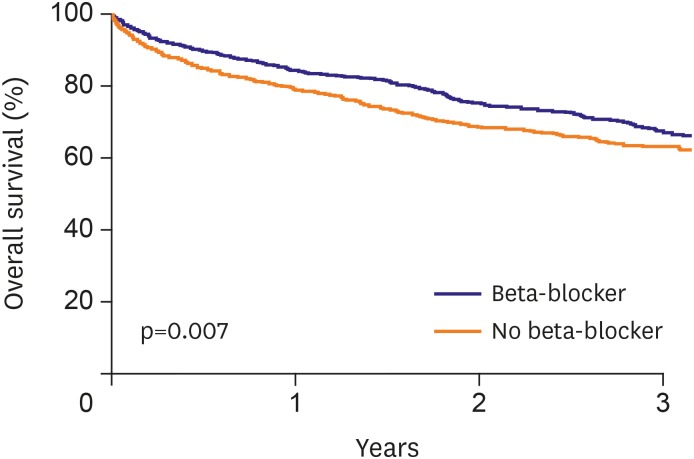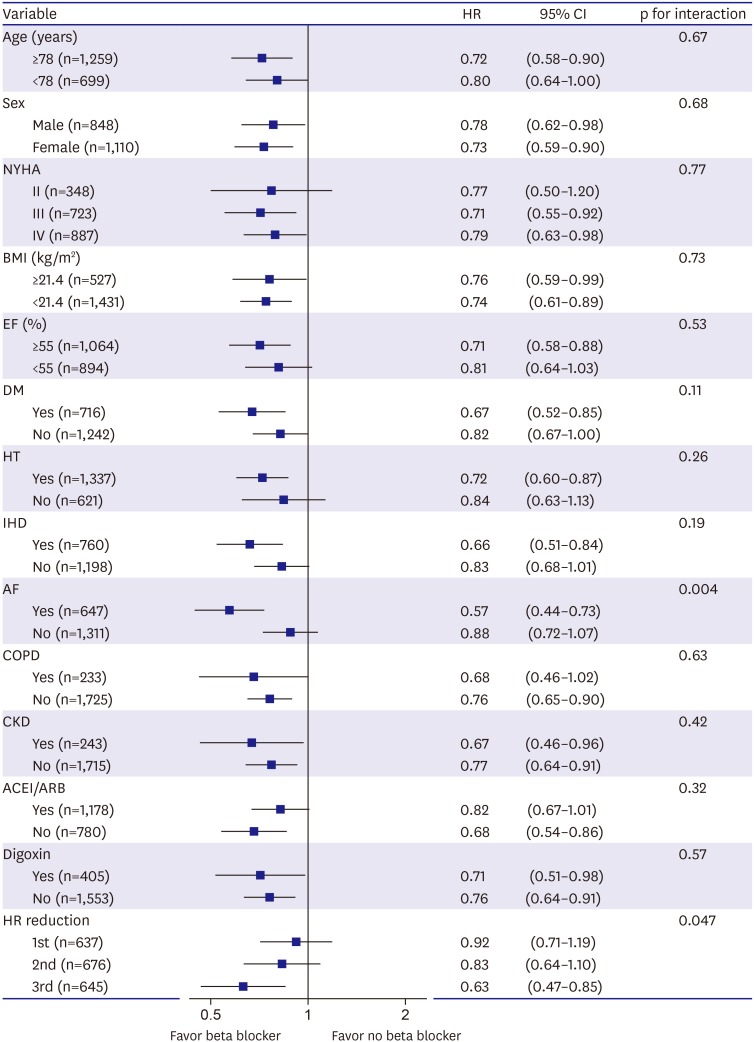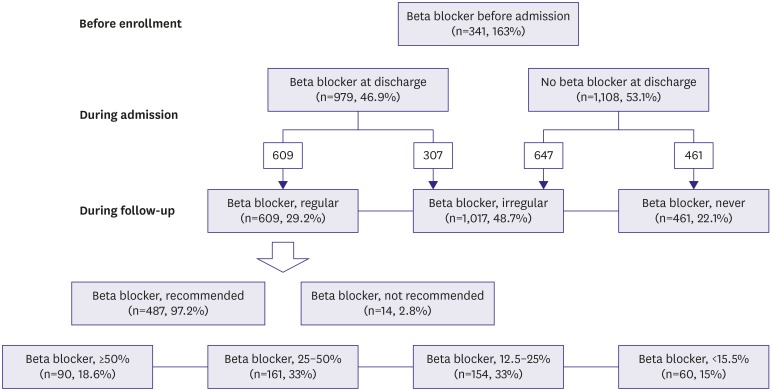Korean Circ J.
2019 Mar;49(3):238-248. 10.4070/kcj.2018.0259.
Beta-Blockers in Patients with Heart Failure with Preserved Ejection Fraction: Results from The Korea Acute Heart Failure (KorAHF) Registry
- Affiliations
-
- 1Division of Cardiology, Department of Internal Medicine, Seoul St. Mary's Hospital, College of Medicine, The Catholic University of Korea, Seoul, Korea. whitesh@catholic.ac.kr
- 2Department of Biostatistics, University of Ulsan College of Medicine, Asan Medical Center, Seoul, Korea.
- 3Department of Cardiology, Cardiovascular Center, Seoul National University Bundang Hospital, Seongnam, Korea.
- 4Division of Cardiology, Heart institute, Asan Medical Center, University of Ulsan, Seoul, Korea.
- 5Department of Internal Medicine, Sungkyunkwan University College of Medicine, Seoul, Korea.
- 6Department of Internal Medicine, Chungbuk National University College of Medicine, Cheongju, Korea.
- 7Department of Internal Medicine, Kyungpook National University College of Medicine, Daegu, Korea.
- 8Department of Internal Medicine, Yonsei University College of Medicine, Seoul, Korea.
- 9Department of Internal Medicine, Yonsei University Wonju College of Medicine, Wonju, Korea.
- 10Department of Internal Medicine, Heart Research Center of Chonnam National University, Gwangju, Korea.
- 11Department of Internal Medicine, Seoul National University Hospital, Seoul, Korea.
- KMID: 2438534
- DOI: http://doi.org/10.4070/kcj.2018.0259
Abstract
- BACKGROUND AND OBJECTIVES
Beta-blockers are indicated in patients with heart failure (HF) with reduced ejection fraction. However, their efficacy in patients with HF with preserved ejection fraction (HFpEF) is uncertain. We investigated the hypothesis that beta-blockers are associated with reduced adverse events in patients with HFpEF.
METHODS
The Korea Acute Heart Failure (KorAHF) is a prospective observational multicentre cohort study. The 5,625 patients hospitalized for acute HF syndrome in 10 tertiary university hospitals across the country have been consecutively enrolled between March 2011 and February 2014. Of these patients, 2,152 patients with HFpEF (ejection fraction ≥40%) were investigated. The primary outcome was all-cause mortality according to beta-blocker use.
RESULTS
During a median follow-up duration of 807 days, 702 patients died. In Cox proportional hazards model beta-blocker use was associated with a 14% reduced all-cause death (hazard ratio [HR], 0.86; 95% confidence interval [CI], 0.75-0.98), but not with reduce rehospitalization (HR, 1.03; 95% CI, 0.85-1.27). In the propensity-score matched population, beta-blockers were also associated with reduced all-cause death (HR, 0.80; 95% CI, 0.69-0.94) but not with reduced rehospitalization (HR, 1.08; 95% CI, 0.87-1.33).
CONCLUSIONS
In Korean patients with HFpEF, use of beta-blockers is associated with reduced all-cause death but not with reduced rehospitalization.
Keyword
MeSH Terms
Figure
Cited by 1 articles
-
Beta-Blockers in Heart Failure with Preserved Ejection Fraction: Could Their Use Be Vindicated as an Acceptable Option in the Future Treatment Guideline?
Jae Yeong Cho
Korean Circ J. 2019;49(3):249-251. doi: 10.4070/kcj.2018.0431.
Reference
-
1. Steinberg BA, Zhao X, Heidenreich PA, et al. Trends in patients hospitalized with heart failure and preserved left ventricular ejection fraction: prevalence, therapies, and outcomes. Circulation. 2012; 126:65–75. PMID: 22615345.2. Borlaug BA. The pathophysiology of heart failure with preserved ejection fraction. Nat Rev Cardiol. 2014; 11:507–515. PMID: 24958077.3. Butler J, Fonarow GC, Zile MR, et al. Developing therapies for heart failure with preserved ejection fraction: current state and future directions. JACC Heart Fail. 2014; 2:97–112. PMID: 24720916.4. Senni M, Paulus WJ, Gavazzi A, et al. New strategies for heart failure with preserved ejection fraction: the importance of targeted therapies for heart failure phenotypes. Eur Heart J. 2014; 35:2797–2815. PMID: 25104786.5. Ponikowski P, Voors AA, Anker SD, et al. 2016 ESC Guidelines for the diagnosis and treatment of acute and chronic heart failure: the Task Force for the diagnosis and treatment of acute and chronic heart failure of the European Society of Cardiology (ESC)Developed with the special contribution of the Heart Failure Association (HFA) of the ESC. Eur Heart J. 2016; 37:2129–2200. PMID: 27206819.6. Yusuf S, Pfeffer MA, Swedberg K, et al. Effects of candesartan in patients with chronic heart failure and preserved left-ventricular ejection fraction: the CHARM-Preserved Trial. Lancet. 2003; 362:777–781. PMID: 13678871.7. Pitt B, Pfeffer MA, Assmann SF, et al. Spironolactone for heart failure with preserved ejection fraction. N Engl J Med. 2014; 370:1383–1392. PMID: 24716680.8. Cleland JG, Tendera M, Adamus J, et al. The perindopril in elderly people with chronic heart failure (PEP-CHF) study. Eur Heart J. 2006; 27:2338–2345. PMID: 16963472.9. Yamamoto K, Origasa H, Hori M. J-DHF Investigators. Effects of carvedilol on heart failure with preserved ejection fraction: the Japanese Diastolic Heart Failure Study (J-DHF). Eur J Heart Fail. 2013; 15:110–118. PMID: 22983988.10. Liu F, Chen Y, Feng X, Teng Z, Yuan Y, Bin J. Effects of beta-blockers on heart failure with preserved ejection fraction: a meta-analysis. PLoS One. 2014; 9:e90555. PMID: 24599093.11. Lund LH, Benson L, Dahlström U, Edner M, Friberg L. Association between use of β-blockers and outcomes in patients with heart failure and preserved ejection fraction. JAMA. 2014; 312:2008–2018. PMID: 25399276.12. Lee SE, Cho HJ, Lee HY, et al. A multicentre cohort study of acute heart failure syndromes in Korea: rationale, design, and interim observations of the Korean Acute Heart Failure (KorAHF) registry. Eur J Heart Fail. 2014; 16:700–708. PMID: 24797348.13. Lee SE, Lee HY, Cho HJ, et al. Clinical characteristics and outcome of acute heart failure in Korea: results from the Korean Acute Heart Failure Registry (KorAHF). Korean Circ J. 2017; 47:341–353. PMID: 28567084.14. Kelly JP, Mentz RJ, Mebazaa A, et al. Patient selection in heart failure with preserved ejection fraction clinical trials. J Am Coll Cardiol. 2015; 65:1668–1682. PMID: 25908073.15. R Development Core Team. R: a language and environment for statistical computing [Internet]. Vienna: R Foundation for Statistical Computing;2016. cited 2018 Mar 21. Available from: http://www.R-project.org/.16. Moon KW. R Statistics and Graphs for Medical Papers. Seoul: Hannarae;2015.17. Bavishi C, Chatterjee S, Ather S, Patel D, Messerli FH. Beta-blockers in heart failure with preserved ejection fraction: a meta-analysis. Heart Fail Rev. 2015; 20:193–201. PMID: 25034701.18. O'Connor CM, Fiuzat M, Swedberg K, et al. Influence of global region on outcomes in heart failure β-blocker trials. J Am Coll Cardiol. 2011; 58:915–922. PMID: 21851879.19. Gupta AK. Racial differences in response to antihypertensive therapy: does one size fits all? Int J Prev Med. 2010; 1:217–219. PMID: 21566775.20. Ogawa R, Stachnik JM, Echizen H. Clinical pharmacokinetics of drugs in patients with heart failure: an update (part 2, drugs administered orally). Clin Pharmacokinet. 2014; 53:1083–1114. PMID: 25248847.21. Lim S, Shin H, Song JH, et al. Increasing prevalence of metabolic syndrome in Korea: the Korean National Health and Nutrition Examination Survey for 1998–2007. Diabetes Care. 2011; 34:1323–1328. PMID: 21505206.22. Komajda M, Isnard R, Cohen-Solal A, et al. Effect of ivabradine in patients with heart failure with preserved ejection fraction: the EDIFY randomized placebo-controlled trial. Eur J Heart Fail. 2017; 19:1495–1503. PMID: 28462519.23. Cleland JG, Bunting KV, Flather MD, et al. Beta-blockers for heart failure with reduced, mid-range, and preserved ejection fraction: an individual patient-level analysis of double-blind randomized trials. Eur Heart J. 2018; 39:26–35. PMID: 29040525.24. Kotecha D, Holmes J, Krum H, et al. Efficacy of β blockers in patients with heart failure plus atrial fibrillation: an individual-patient data meta-analysis. Lancet. 2014; 384:2235–2243. PMID: 25193873.
- Full Text Links
- Actions
-
Cited
- CITED
-
- Close
- Share
- Similar articles
-
- Beta-Blockers in Heart Failure with Preserved Ejection Fraction: Could Their Use Be Vindicated as an Acceptable Option in the Future Treatment Guideline?
- Optimal Management of Heart Failure with Preserve Ejection Fraction
- Role of Beta-blockers in Treatment of Heart Failure
- Beta-blocker therapy in patients with acute myocardial infarction: not all patients need it
- Paradigm Shifts of Heart Failure Therapy: Do We Need Another Paradigm?




